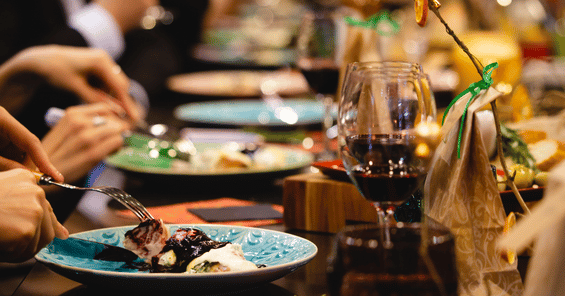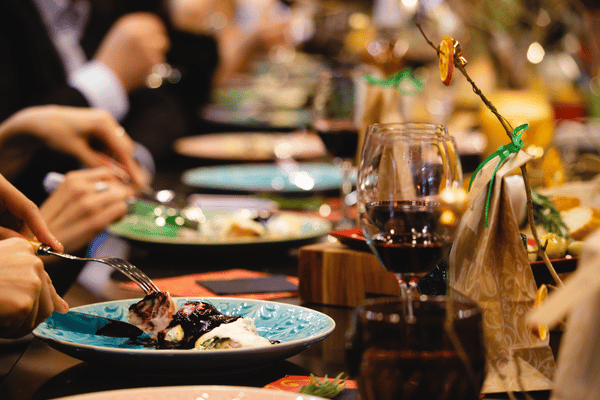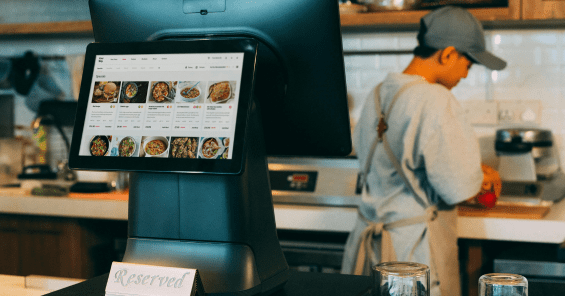

Eco-Friendly Restaurant Guide: Lower Food Costs and Food Waste and Make a Difference
"Unlock 8x ROI with Sustainable Practices for Your Restaurant: A Comprehensive Guide" - Tackling food waste and implementing eco-friendly practices in your restaurant may seem like a daunting task, but did you know it could net you an 8x ROI? Dive into our in-depth guide that breaks down the Food Recovery Hierarchy and offers actionable steps to not only cut down on waste but also enhance your bottom line.
Sustainability. It’s a buzzword on the tongue of every restaurant owner and manager. And yet, sometimes simply dealing with the day-to-day craziness of running a restaurant means that you have little energy to focus on ways to be kinder to the environment. Also, it seems like many sustainable practices cost money. Who’s got the budget for going green if it costs green? It’s true that some practices require an investment, if not a financial one, then an investment of time. But chew on this: for every dollar you invest in sustainable practice for your restaurant, you will net an 8x ROI. In other words: an investment today means profit down the road.
Six Foolproof Restaurant Cost Management Techniques
Maximize your restaurant's profitability with this essential eBook. 📈 Learn foolproof cost management techniques and unlock proven strategies for supplier negotiations and brand loyalty. 👩🍳🤝

Not only that, but also your customers—particularly if they are Millennials—are willing to pay a premium for sustainable products and services. As you adopt more sustainable practices in your restaurant, you can market that fact and increase prices to cover your costs. And the benefit goes beyond just what your business can save or net in additional revenue. In the US alone, reducing waste by just 20% can have the following impact in just one year:
- Create $2 billion in business profit
- Save consumers $6 billion
- Recover 1.8 billion in meals
- Create 15,000 jobs
- Conserve 1.6 trillion gallons of water
- Reduce 18 million tons of greenhouse gas emissions
ReFED, a nonprofit committed to reducing food waste, developed what it calls the Food Recovery Hierarchy. We’ll explore the three tenets of this framework (Prevention, Recovery, and Recycling) as well as other ways to make your restaurant business more sustainable in this eco-friendly restaurant guide to lower food costs and food waste and make a difference.
Prevention
Every year, 63 million tons of food is wasted in the US alone. While that is spread across farms, industries, and households, food service and retail bear 40% of the responsibility for this annual waste. This is a shame because so much of it can be prevented. Even dealing with food waste is expensive: the US spends over $218 billion growing, processing, transporting, and disposing of food that never gets consumed. These numbers are startling, but they’re also easy to ignore. After all, how much could your little restaurant really contribute to the bigger picture of food waste, right? Wrong. The average restaurant wastes half a pound of food for every meal served. Think about that for a moment. Preventing food waste not only keeps it out of landfills, but it also reduces your restaurant costs, passes on cost savings to your customers, and impacts the environment in a positive way. Let’s explore some strategies for preventing food waste.
1. Use Every Ingredient
If you plan ahead with your dishes, you can maximize each ingredient so that none gets wasted. Think of all the components of a given recipe and make sure you’re maximizing the use of each ingredient by using it in multiple dishes. You might typically use the white ends of leeks for a side dish then toss the tops, but get creative instead: they can go into a vegetable stock or used as a garnish. Dried out rolls from the bread basket can be turned into croutons. Extra meat from one recipe can go into a soup. It may take some innovation to come up with ways to minimize food waste, but you might end up with a winning dish as a result!
2. Reduce Portions
If you’ve done food cost calculations, you know your recipe cost is based on specific portions of each ingredient. Increasing these even a tiny bit will throw off both your profit per dish as well as the recipe, so teach your kitchen staff how to portion ingredients properly with weighing and measuring tools. But sometimes you’ve created a portion that’s bigger than your customers really need. If you notice diners’ plates returning to the kitchen with a sizeable portion of a particular dish untouched, realize that you may be serving a larger than necessary serving. Pare back just a little and you’ll cut down on the food cost for that dish as well as reduce food waste. Using a recipe tool built into restaurant management software can help you determine the correct portions and track food waste.
3. Plan Your Daily Special
Knowing what perishable items you’ve got in the kitchen, create daily specials that will use up anything that will go bad within a few days. If you over-ordered shrimp and risk it going bad if it doesn’t get eaten in the next day, take this opportunity to offer a “special” of the day: shrimp scampi, shrimp tacos, or fried shrimp. By putting attention on a limited-time-only dish, you sell more of it and ensure that you don’t end up dumping shrimp gone bad.
4. Make the Most of Your Inventory Management Software
The purpose of inventory software is to help you keep on top of the ingredients you have on hand and to ensure that you neither run out nor have to throw old food out. Make sure you set par levels so that you are alerted in advance of running out of ingredients and log waste so you know the true food cost for a dish. Also, make sure your inventory practices are running smoothly. If you use inventory management software, it should be simple since every time a dish is ordered through your POS, the ingredients are subtracted from your inventory. It is, however important to count inventory once a month and key items on a weekly basis to determine actual usage of your inventory every month.
5. Buy in Bulk
Not only is it cheaper to buy ingredients in bulk, it also reduces the unnecessary packaging you have to then throw away or recycle. Just think about an order of meat: it may be packed in individual plastic vacuum packaging...inside a large plastic bag...inside a cardboard box. Or consider 25 individual bottles of olive oil versus one large tin. Each product you order comes with waste, so be mindful of how much you could reduce simply by ordering in bulk as well as paying attention to the packaging and working with a vendor that strives to minimize waste.
6. Control Disposable Flow
We’ve all suffered this scenario: you put a napkin dispenser out and when a customer pulls one, two dozen come out. More than likely, she won’t put them all back. You can control both your napkin costs as well as waste if you provide a limited number of napkins with each order. Also keep disposable serviceware behind the counter so you can control distribution. For take out, always ask the customer if he needs serviceware, napkins, or sauce, rather than defaulting to always give them. Place sugar, oil, salt, pepper, et cetera in reusable glass containers instead of individual disposable packets to minimize waste. If you want to make napkins available in the dining area, use a dispenser that really distributes just one at a time.
Recovery
The next part of the ReFED hierarchy for eliminating food waste is Recovery. What you do with the food you have can keep it out of the landfills.
7. Donate it to a Charity
Consider this: 49 million Americans struggle to put food on the table. Donating food you can’t use to food banks not only prevents food waste, but it also saves lives. There’s even tax incentive for doing so: assuming you donate to a qualified charity (it has to be a 501(c)(3) not-for-profit for you to qualify for tax incentives), you can write off those food donations.
8. Feed Animals
Sometimes, however, your wasted food isn’t fit to give people. In that case, you can donate it to farms to feed animals. Innovative brands like GrubTubs are finding ways to turn a restaurant’s food scraps into affordable, sustainable animal feed for local farms. The added benefit is that this removes some of the strain on the agriculture industry by reducing the amount of feed needed to raise these animals, thanks to restaurants like yours contributing to the food flow for them. It also cuts down the time you have to spend separating food scraps from your waste stream, and reduces the cost to haul away waste as it weighs less.
Recycling
The final component of ReFED’s hierarchy is Recycling. While this is a commonplace enough endeavor at just about every restaurant, there is still room for improvement. Because recycling costs about half of what trash does per pound, there is also economic incentive in making sure your recycling processes are up to par. This can be as simple as ensuring you’ve got signage showing how to separate waste into categories (trash, recycling, and composting) in both back and front of house. Include signage with specific pictures of what goes into each can. Increased efforts to recycle can divert 2.6 million tons of waste from landfills and reduce CO2 emissions by 1.9 million tons.
9. Minimize Package & Service Ware Waste
Food isn’t the only thing getting wasted in restaurants. While 72% of restaurants currently purchase at least some packaging and supply products made of recycled material (and 30% buy at least some compostable products), there’s still a long way for restaurants to go according to ReFED’s Food Waste Action Guide. As it stands, 23% of landfill waste is from discarded packaging. Preventive practices can be easy to adopt and have a great impact on the environment. Simply switching to recyclable or compostable disposable serviceware is an easy place to start. While it might seem time-consuming to have to switch items and/or suppliers to get more sustainable products with minimal packaging, a quick email to your current supplier asking for a quote for sustainable alternatives to the specific products currently purchased shouldn’t take too much effort and can have positive results. And rather than using plastic gloves for every aspect of the kitchen, only use them when handling ready to eat foods. Encourage using sanitizer instead of gloves when appropriate.
10. Compost
Once trendy, composting has become a part of many restaurants’ practices. Check with your hauler to see if they provide composting services, and find out what can be composted (some accept meat and compostable packaging, while others don’t). Simply place a composting bin in the kitchen where it’s easy to dump scraps in, and educate your kitchen staff about what can and can’t go in there. If you don’t have a garden at your restaurant, consider donating the compost to a local community garden or hiring a service like Dallas-based Turn Compost, which provides composting bins to restaurants and then picks them up when they’re full. The scraps are given to farmers, who then use it to create compost they use to grow their crops.
11. Audit Your Recycling
You may think that your staff is doing a great job of recycling, but you won’t know until you dig through your trash and recycle bins. You may find that your employees consistently don’t recycle one particular packaging type because they’re unaware that it can be recycled. An in-house session on what can and can’t be recycled can boost their adoption and ensure best practices. Signate in back-of-house with clear pictures can also foster adoption of recycling practices.
12. Recycle Cooking Oil
As we become more aware of how our consumption of natural resources is taxing the planet, we’re also coming up with innovative solutions to find alternative options. Your old cooking oil can become biofuel, which is better for the environment and doesn’t impact global warming.
13. Upcycle What You Can
Recycling packaging isn’t the only solution for keeping it out of the landfill. Many restaurants are coming up with innovative solutions to upcycle these materials. BURGER FI, a fast-casual burger concept, used over 700,000 milk jugs to create tables for its locations, and more than 150,000 Coca-Cola bottles to create tables. There’s no limit to your creative options here. You could use plastic crates for gardens, create paper from cardboard waste, or send your recyclables to a brand who will turn it into clothing or accessories.
Environmental Awareness
We’d like to add a few other categories to the tips for how to make your restaurant more sustainable, beginning with environmental awareness because sustainability isn’t just about minimizing food waste or recycling: it’s also about reducing the natural resources and energy you use in your restaurant. Speaking of energy: did you realize that 35% of your restaurant’s energy consumption goes into food prep? After that, your HVAC, sanitation, lighting, and refrigeration take up the rest of the energy pie. While you certainly can’t do without any of these components, there are ways you can conserve energy.
14. Invest in High-Efficiency Systems
If you’re of the “if it ain’t broke” school of thought, you may be limping along with a still-functioning but highly-inefficient HVAC system. Yes, it costs money to update this, but the long-term cost savings make it well worth the investment. The good news is that there are tax incentives for going green with your heating and cooling systems. This can offset the sticker shock if the budget is beyond what you expected. Keep in mind that your energy bills should immediately be lower, so you’ll quickly recuperate your expenses in those cost savings. When shopping for equipment, always look for Energy Star rated products.
15. Use Smarter Lighting
This is a relatively simple and affordable way to go green quickly. Replace incandescent bulbs with Energy Star rated LEDs, even in your restaurant signage, exit signs, and other less obvious lit areas. Install motion sensor lighting in restrooms, and daylight sensors in the dining area so that you’re not constantly managing lighting conditions manually.
16. Control Water Flow
Water is another resource that may be wasted without sustainable measures in place. Your kitchen staff might be adept at only turning on the faucet when they need it, but what about your public restroom where a child might leave the faucet on to overflow for an hour before someone catches it? Install low flow as well as touchless faucets so that water only comes on when a guest needs it. Dual flush toilets give guests the option of a little or a lot of water with their flush and can reduce water waste.
17. Buy Used When You Can
It may not be necessary that all the furniture, fixtures, and decor for your restaurant be brand new, and buying used puts less tax on the environment (not to mention your budget). Look for restaurant auctions to get great deals on tables, chairs, bars, and equipment. If you’re in the design process, consider using reclaimed wood as part of the plan. Not only is it sustainable to use wood from dismantled furniture or buildings, but it also tells a story. Imagine your customers’ delight when you tell them that the bar they’re sitting at once was used in a train station in Santa Fe!
18. Hire Green Cleaners
Here’s something you might overlook in your quest for sustainability: how your restaurant is cleaned. Harsh chemicals like Volatile Organic Compounds are commonly used to clean restaurants, but these all too easily end up in waterways where they kill plant and marine life. There are certified green cleaning companies you can hire that will use environmentally safe cleaning products that will get your restaurant sparkling without harming the planet.
19. Get Employees on Board
You may have only a handful of employees and think that they couldn’t possibly have much of an environmental footprint. But consider that likely, every shift, each one drinks from a disposable cup and maybe eats a meal on a disposable plate. What small but positive change could you create by giving them reusable dishes? It’s an easy and affordable way to be more sustainable. Educate your staff on ways they can be kinder to the planet at work and at home. Keep your staff engaged in the process of becoming more sustainable so that they feel like they’re contributing to their local community and the greater environment. Another way to engage employees in getting excited about sustainability: motivate them by rewarding good behavior. You could create a quarterly contest where employees come up with innovative ways to make the restaurant more sustainable, and you could reward the best idea with a gift card or a paid day off. You can also motivate them by including them in the process. Set goals (“reduce our waste by 50%”) and keep a scoreboard for how you’re doing in reaching those goals where everyone can see.
20. Find Sustainable Sourcing
McDonald’s is just one brand who has committed to combat deforestation by switching to more sustainable sources for packaging. Though your restaurant doesn’t have nearly the global impact that McDonald’s does, you can still make an effort to invest in materials that are recyclable and sustainable. Not only can you elect to buy sustainable products but you can also choose to work with vendors that use minimal or recycled packaging. This communicates your commitment to better practices, which, in turn, helps change the tide for how restaurant vendors practice their business.
Sustainable and Ethical Food Sources
Food costs are likely your highest expense, and while sustainable and ethical food sources don’t come cheap, you are making an investment in the planet that will pay you back in goodwill.
21. Care About Where Your Food Comes From (Because Your Customers Do)
Many diners seek restaurants that, like Chipotle, are committed to working with farmers who raise crops and animals in a sustainable and humane manner. In fact, 86% of Millennials want restaurants to be more transparent about where their food comes from, how it’s harvested, and what attributes the ingredients have.Chipotle uses non-GMO, pesticide-free ingredients and pasture-raised and hormone-free animals, and its customers appreciate these efforts. Your best bet is to get to know your food sources. Visit the farms. See how crops are grown and animals are raised. Choose farms that align with your beliefs about what’s good for the environment and for your restaurant.
22. Only Serve What’s in Season
It costs a lot to get a watermelon when they’re out of season, and most of that is the fuel tax you pay to ship it to you from far away destinations. However, watermelon is plentiful and cheap in the summer and probably grown a lot closer. Serving what’s in season not only reduces your costs, but there’s also less of a carbon footprint to get it to you. Also, produce tastes better when it’s in season! Maximize your menu for what’s bountiful right now.
23. Leverage Local
The less distance your produce and meat has to travel, the fewer emissions the transportation to get it to you is putting into the atmosphere. Also, sourcing from local farms is a great way to support your community and it makes it easy for you to visit or get involved with that resource.
Conclusion
Becoming more sustainable is a gradual process, but it’s one that will pay for itself hundredfold. Solutions like these suggestions provide restaurants with nearly $620 million in business profit potential each year (ReFed). What could you do with a little more profit?

Automate your inventory management, control food costs, and streamline back-of-house processes effortlessly with MarketMan's restaurant software. MarketMan enables restaurateurs to eliminate manual tasks, reduce waste, and drive success through strategic insights. Experience a new level of restaurant efficiency. Schedule a demo now to learn how MarketMan can revolutionize your operations!
Author
Contributors
If you have any questions or need help, feel free to reach out
Don't miss out on maximizing your restaurant's profits! Calculate your ROI with MarketMan
Join over 18,000 restaurants and get the hottest restaurant tips delivered to your inbox
You may also be interested in
Ready to get started?
Talk to a restaurant expert today and learn how MarketMan can help your business






